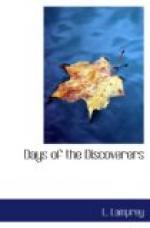As the exile of Spain began to know the country he sometimes ventured on journeys alone, without the tribe, to the north, away from the coast. In these wanderings he met with tribes whose language was not wholly strange, but whose customs and occupations were not exactly like those of his own Indians. Once he found a village of deerskin tents where the warriors were painting themselves with red clay, for a dance. He remembered that the squaws, when he came away some days before, were in great lamentation because they had no red paint for their baskets. He took out a handful of shells and found that these Indians were only too pleased to pay for them in red earth, deerskin, and tassels of deer hair dyed red. They would hardly let him go till he promised to come again and bring them more shells and shell beads. This suggested to him a way in which he might make himself of use and value.
Longer and longer journeys he took, trading shells for new dyes, flint arrow-heads, strong basket-reeds, and hides and furs of all sorts, learning more and more of the country as he trafficked. Once he found families living in a house built of stone and mud bricks, in the crevice of a cliff, getting water from a little brook at the base of it, and raising corn and vegetables along the waterside. Their houses had no real doors. They had trap-doors in the roof, reached by a notched tree-trunk inside and one outside. The corn that grew in the little farm at the foot of the cliff was of different colors, red, yellow, blue and white. Each kind was put in a separate basket. Each kind of meal was made separately into thin cakes cooked on a very hot flat stone. A handful of the batter was slapped on with the fingers so deftly that though the cake was thin, crisp and even, the cook never burned herself. The people were always on their guard against roving bands of Indians who lived in tipis, or wigwams, and were likely to attack the cliff-dwellers at any moment.
Cabeca de Vaca became interested in these wandering tribes, and moved north to see what they were like. He found them quite ready to trade with him and extremely curious about his wares. They had hides upon their tipis of a sort he had not seen before, not smooth, but covered with curly brown fur like a big dog’s. It was some time before the Spanish trader made out what sort of animal wore such a skin, though he knew




